Lately I’ve been reading And Yet the Town Moves (それでも町は廻っている) on Piccoma. I read the Chinese translation a long time ago, and this time I wanted to try the original Japanese. What really stood out to me was how casual and free-flowing the dialogue is, much more so than other anime or dramas I’ve watched.
Here’s one passage that really gave me trouble. I could parse all the grammar, but I still couldn’t grasp what they were trying to convey until I looked up the translation:
What are some good resources for learning casual Japanese? I found an old thread which recommended Let’s learn Japanese from small talk!, but I’ve listened to them for some time and I think their conversation is still more structured.

